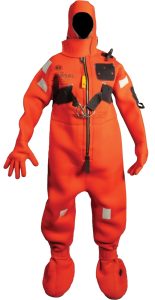Survival suits on! The crew of the Erla-N takes us along on their man overboard drill! Watch as they practice signaling, marking the location, turning the vessel, preparing a rescue swimmer, deploying a sling, and using the boat’s hydraulic system to lift the MOB and rescue swimmer. Brrrr!
Watch: Erla-N 2021 Man Overboard Drill
What is a Man Overboard Drill?
Man overboard (MOB) drills are a critical element of vessel safety and are designed to prepare the crew to jump into action quickly in the event of a crew member falling overboard. The drills ensure that everyone on deck knows best practices and has rehearsed their assigned role. In the icy waters of the Bering Sea, every second counts and preparedness saves critical seconds and minutes in the rescue effort.
What are the Typical Steps in a Man Overboard Drill?
- Wear personal flotation devices: wearing PFDs dramatically reduces deaths associated with falls into cold water.
- Sound the alarm (signaling): the crew yells “Man overboard!!” to alert the captain, crew, and nearby vessels that there is a man overboard (MOB).
- Communicate position of MOB: post a lookout to continually point at the victim, track their location, and keep visual contact with the MOB throughout the recovery effort.
- Mark the MOB location and deploy flotation devices: throw in buoys and life rings and input the spot into GPS as well.
- Turn the vessel: return to the location where the crewman went into the water.
- Prepare a rescue swimmer: help the rescue crewmen get into an immersion suit with a detachable tether.
- Carefully approach the MOB: continue to maintain visual contract, keeping the boat at a safe distance depending on conditions.
- Deploy a rescue device: throw a life ring, lower a sling, ladder, or other boarding devices to help the MOB get back over the rail.
- Use a hauler: use a hydraulic hauler to help lift the MOB out of the water.
- Get help: If necessary, alert the Coast Guard to assist with the rescue or to provide medical attention to the victim.
What should You Do to Survive a Fall into Cold Water?
To help better understand the effects of cold-water immersion on the body, Dr. Giesbriecht (also known as “Dr. Popsicle”), developed the 1-10-1 principle.
- 1 Minute to get your breathing under control
- 10 Minutes of meaningful movement
- 1 hour before you become unconscious due to hypothermia
Due to the cold shock response, the initial fall into cold water can literally take your breath away. To survive these first few minutes, it is critical to stay calm, avoid panic, and use the first minute in the water to control your breathing. To prevent the hyperventilation that is common with a fall into cold water, breath out through pursed lips. Over the next 10 minutes, you will begin to lose muscle control due to cold incapacitation. It is important to use this time to plan and act before you are unable to do so. Get as much of your body out of the water as possible and keep your head above water with a floatation device if available. It generally will take about an hour before you become unconscious due to hypothermia.
What is an Immersion Suit?
The youngest member of the F/V Erla-N demonstrates how to don an immersion suit quickly: Immersion Suit Drill
Sometimes called a survival suit, an immersion suit is a waterproof dry suit that offers protection for commercial fisherman in the case of assisting in a rescue or needing to abandon their vessel while at sea. Donned in the case of an emergency, the suits typically includes an inflatable pillow that helps to keep the wearer’s head above water as well as other features that improve survival and rescue odds.
Why are Personal Flotation Devices (PFD) So Important?
Being able to stay afloat is critical to being able to survive a fall overboard. This is particularly true in cold water conditions where cold incapacitation (the loss of the ability to coordinate the movements needed to swim) generally leads to death before hypothermia. Wearing a life jacket or other personal flotation device allows the victim to stay afloat long after cold incapacitation has set in. This additional time is often the critical factor in rescue.
Man Overboard Drill and Cold Water Safety Resources:
- Video: “Man Overboard Prevention and Recovery”
- The CDC has prepared an excellent overview on preventing and reacting to falls overboard: Commercial Fishing Safety: Falls Overboard
- Cold Water Safety in Alaska
- Video: 1-10-1 Cold Water Principle
- US Army Tips for Surviving a Fall into Cold Water
Join the Crew!
Subscribe to Keyport’s YouTube Channel or follow us on Instagram for to see future man overboard drills and dispatches from the Golden King crab fishing grounds.



